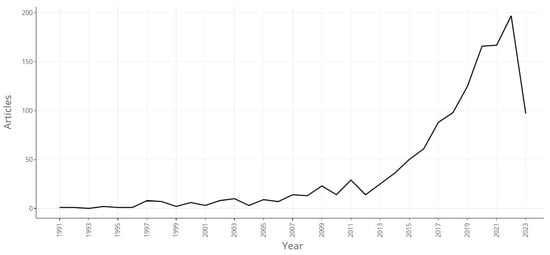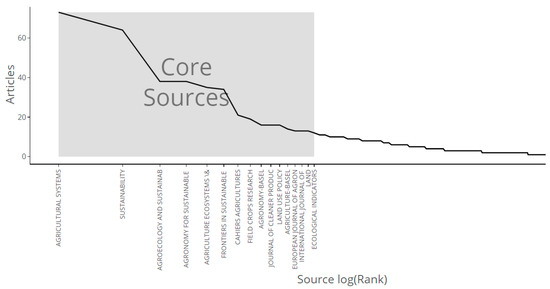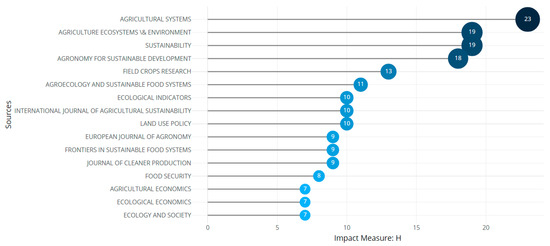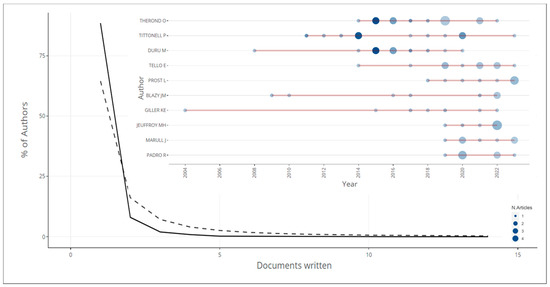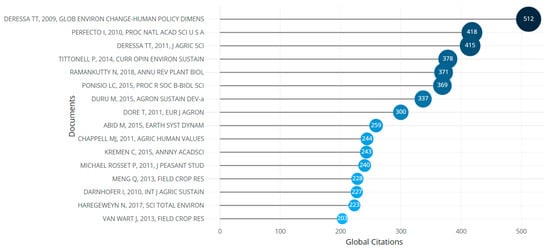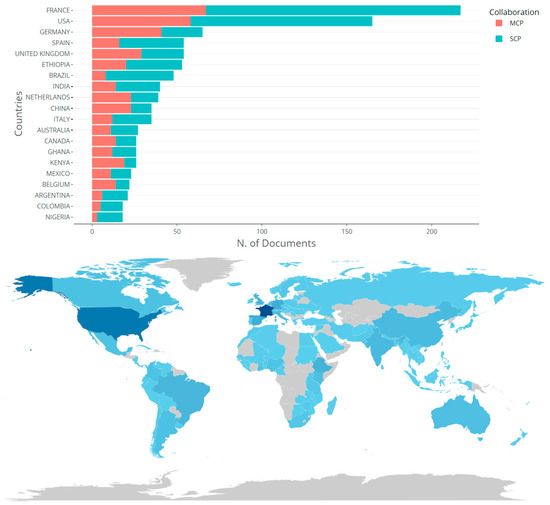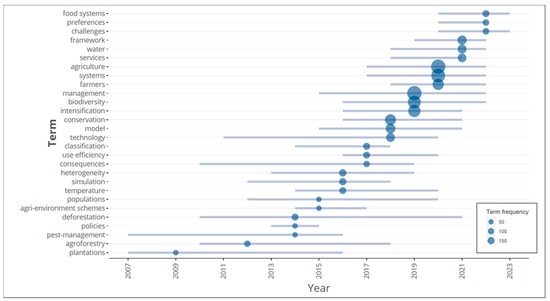Most trendy keywords and topics.
Using clustering algorithms provided by the bibliometrix package, It is able to link the various themes based on selected article keywords. This clustering resulted in five primary thematic classes covering: global agriculture, adoption of agroecology, climate change, management of agricultural landscapes, and the development of farmers’ knowledge.
2.6. Research Gaps: Methodology for Agroecological Transition Modeling
Although questions relating to the identification of the determinants and strategies of agroecological adoption are omnipresent in the literature, research with a view to developing robust and comparable methods to achieve this from one geographical area to another has yet to be carried out. For instance, keyword analysis revealed that machine learning methods and econometric ones are not widely used to model the process of farm agroecological adoption. Most methodological studies have focused on developing a framework for evaluating the process of adopting agroecology using indicators or a multi-criteria approach
[2][8][52][53].
Agroecological transition can occur at any scale (plots, fields, farms, nations, etc.). However, analyzing this transition at the country scale can be more complex than at a plot scale, and the transition from one scale to another is not always obvious
[54]. The spatial dimension, or scale at which agroecology is to be adopted, must be clearly defined as part of the analysis of the agroecological transition. Plot scale, farm scale, and territorial scale, such as the country or region, can be distinguished as the three main scales
[2][8][55]. To date, the farm transition has not received much attention as a research topic
[56][57]. Transition is generally studied at the scale of the territory or landscape, as shown in the keyword analysis section. Thus, despite the fact that the farm is the core of the agricultural production system, only a small number of studies concentrate on this level
[58]. Additionally, a time dimension must be included in the transition analysis to enable performance comparison and horizon forecasting
[59]. The results will be even more significant if the time dimension is taken into account when comparing the economic performance of agroecological farms with that of other production systems, such as the conventional system. In fact, the adoption time increases with increasing spatial dimensions. Therefore, in order to plan the technical and financial resources required to achieve the desired results in a timely manner and use a method that is appropriate, modeling work will need to take into account the correlation between time and space.
Agroecological practices can be viewed as innovations that directly involve stakeholders in the innovation process while mobilizing a variety of local knowledge sources and the most cutting-edge scientific knowledge to optimize farm production
[60]. According to the general framework of the theory of the “diffusion of innovation”
[61], The adoption function would take the shape of an ‘S’, characteristic of the logistic function. In this regard, econometric methods may prove useful for simulating the adoption of agroecology and its scaling up. More broadly, automatic learning models can be used through the multiple algorithms they provide, such as multiple logistic regression (LRM), ensemble methods (decision trees), and non-parametric methods (naïve Bayes, k nearest neighbors), to learn from features and make efficient modeling
[62][63][64][65].
3. Summary
The agroecological transition issue’s significance is growing over time. Indeed, the rise in the number of publications on the topic attests to its significance and can be interpreted as a sign that it is reaching a certain stage of development. Additionally, the inclusion of agroecology in the research domains of international organizations, such as the Food and Agriculture Organization of the United Nations (FAO), demonstrates that its status as a significant scientific and research field is expanding significantly
[66].
The walktrap clustering algorithm was used to group keywords into five main thematic classes: agriculture, landscape, adoption, climate change and knowledge. Apart from the question related to agriculture and biodiversity management, other studies, such as
[67][68][69], had not previously identified climate change, knowledge development, and adoption as research fronts. Adoption, knowledge development, and climate change are some of the trendiest issues and are identified as central issues. Although the importance of the themes varies from period to period, some of them, such as those dealing with the management of agricultural landscapes or biodiversity, have remained constant over time. Given the topicality of climate change issues, in the process of modeling the adoption of agroecology, it would be interesting to quantify the role of agroecological practices in mitigating the effects of climate change.
One of the challenges facing current agricultural research is finding the best strategies for the sustainable transformation of current production systems. Agroecology is proving to be one of the most suitable alternatives to the problem. Although significant progress is being made around the world, large-scale adoption of agroecology is not yet being observed, and African states should document the wide range of traditional knowledge (linked to agroecology) practiced on the continent in order to promote its adoption. The study demonstrates that while farming systems management, agricultural intensification, and biodiversity management have long been addressed in the past, those relating to the study of strategies and determinants around the adoption of agroecology, the development of knowledge and innovations for food sovereignty, and the study of climate change impacts on farm productivity still need to be explored in depth. Furthermore, there is no universal agreement on the best way to model the transition of farms to an agroecological system, as each stage of this process may require a specific methodological approach, and machine learning methods reputed for their robustness and objectivity are still unexploited. Comparisons between conventional and agroecological production systems, based on real and high data quality, could allow a real transition to take place in the world and Africa in particular. One of the limitations of performance evaluation is the inability to classify farms in a reliable and consensus-based manner. Using machine learning techniques (such as decision trees, naïve Bayesian classification, multinomial logistic regression, and more) will help to overcome this limitation and complete the other evaluation and modeling steps that are still closely related to classification. Finally, future research can cover other databases, such as Scopus, to make comparisons with the findings of the present study.

